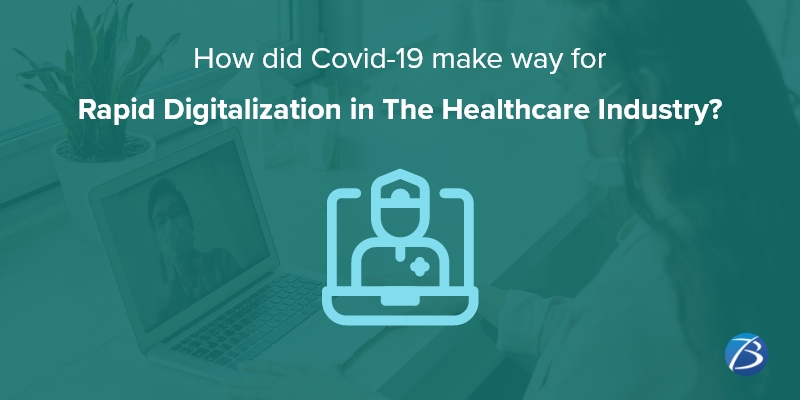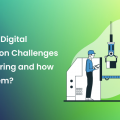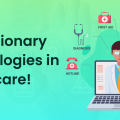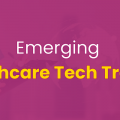Digital Transformation of Healthcare amid COVID-19 Pandemic

COVID-19 pandemic has changed our life in several ways. We witnessed a surge in technology-led adoptions across several industries to prioritize convenience and accessibility over every other aspect. The overall impact has been positive as different industries and services have gone digital, benefitting the masses with fast and easy accessibility to products and services. These digital initiatives helped the healthcare sector attain a digital infrastructure at a very fast pace. Healthcare app development companies also contributed in attaining this feat. Esteemed app development companies like Biz4solutions have in-house healthcare app developers who are ready to help a healthcare provider of any capacity to uplift its brand recognition with robust and user-friendly applications. Basically, the pandemic exposed the bottlenecks of the operations and supply chain in the healthcare sector, helping the healthcare providers to fill the gaps and boost the infrastructure with digital offerings. We have seen a slew of changes and upgrades in the healthcare sector which are here to benefit us in the long term.
Different Ways of Digital Transformation in Healthcare Sector:

1. Enhanced patient safety with personalized care
Amid the pandemic situation, everyone went through a period of anxiety and doubts over visiting a healthcare facility and meeting a doctor in person. The healthcare centers and hospitals started remote patient engagement programs to mitigate this escalating anxiety in people. Digitalization of healthcare introduced telemedicine, one of the best technological advancements in the healthcare sector. It enables people to get timely medical assistance. In the bid to solve COVID-related medical issues, we have solved the issues faced by the general public in terms of convenience, long-distance, and long wait time. The telemedicine application saves time and reduces the footfall in any hospital, curbing any further COVID infection caused by close proximity.
The healthcare providers revived their medical infrastructure to integrate emails, texts and voice messages in their system to keep a tab on the surging telemedicine usage. These providers were also entrusted with the task of educating millions of people about the pandemic and recording all the related symptoms and updates. This humungous task wouldn’t have been possible without swiftly upgrading the digital infrastructure. There was a surge in messages and reminders regarding COVID-related precautions which was carefully handled with digital capabilities.
2. Advanced portable diagnostics
With the digitalization of healthcare, imaging modalities evolved. However, the adoption of portable imaging solutions escalated amid the pandemic situation when the hospitals started flooding with COVID patients. Portable ultrasound was used to facilitate competent healthcare in emergency departments and makeshift triage tents. These handheld ultrasound systems were used by medical professionals to assess different health conditions such as acute pneumonia to provide immediate medical assistance. Digital capabilities made diagnostics available to large masses in the troubled times.
3. Re-defined fundamentals
The fundaments of the healthcare sector had to be re-thought to support the digitalization of healthcare to provide faster service to patients. These fundamentals can be divided into different aspects.
- New presets and protocols
The steep rise in the number of COVID patients led to an acute shortage of medical professionals and technicians. The protocols of using different medical equipment such as radiology equipment were changed to introduce easy-to-follow protocols to help the medical professionals scan the suspected COVID patients at a faster pace. Such initiatives were aimed to get a quality and consistent image for the first-time diagnosis to escalate the speed of treatment. Medical strategies were designed to adopt digital strategies for medical diagnostics to fasten every process.
- Real-time virtual collaboration
Different medical professionals including radiologists, oncologists, and cardiologists started working from home. To facilitate a smooth functioning with remote working, many PACS workstations and tele-ultrasound platforms were introduced to empower the remote working professionals with the ability to access and read test reports, images, etc from home. We witnessed a major example of the digitalization of healthcare in pathology with new regulations in the wake of the COVID-19 pandemic. The digitized workflows in the pandemic gave way to new forms of collaboration that scaled the productivity of healthcare institutions.
- Better integration with centralized data centers
To handle the increasing chaos in the healthcare centers, centralized command centers were installed to facilitate better governance. These centers are used to integrate data from all the departments to take fast decisions in real-time. Using these centralized systems, the operational and management team worked in coordination to effectively respond to emergencies and uncertain situations. Digitalization of health records and their remote accessibility has significantly improved the capabilities of analytics and real-time decision-making.
4. Digital technologies for maintaining supply chain
For many decades vaccines were administered on a need basis. The COVID-19 pandemic raised many challenges related to transportation, storage, and vaccine equity for the masses. To deal with these logistical challenges, the stakeholders started seeking solutions using digital technologies. Digitalization of healthcare led to the adoption of digital supply chain management systems that brought all the functionaries across different operations on one page, enabling a smooth procurement, storage, and administration of vaccines.
5. Using disruptive technologies to create meaningful insights
Advanced technologies such as Artificial intelligence were successfully used to identify the body parts infected with the virus using different data feeds such as CT scans and blood reports. Many hospitals employed AI to trace the progress of any disease and take effective measures to curb it.
The fast-paced adoption of digital technologies across the healthcare sector has led to a user-friendly digital transformation wherein the healthcare systems have become more resilient and modern. These digital transformations are set to empower the healthcare system with a fundamentally strong infrastructure.
Long-Term Impact of the Digital Transformation
- Transformed customer relationship: The digitized and remotely accessible healthcare facilities are enabling healthcare institutions to provide customer-centered service, gaining more loyalty and trust.
- Higher Return on Investments: The digital transformation is an ongoing process and many more milestones are yet to be achieved. All of these transformations will yield a higher Return on Investment (ROI) in the long term.
- Resilience: The pandemic rattled the conventional supply chain, following which modifications and upgrades were introduced to create a robust healthcare system ready to serve the masses. These improvements will make the healthcare infrastructure ready to deal with pandemic-like situations in the future.
- Digital leadership and governance: The centralized portals and data-sharing capabilities can be used to develop a governance structure aligned to the business strategy and long-term goals.
- Improved workforce utilization: The digital capabilities will help the management to efficiently allocate resources across the supply chain and operations to derive maximum value from it.
The digital transformation of healthcare industry is mid-way and many more digital capabilities are to be integrated into the existing healthcare infrastructure. The players and stakeholders of the ecosystem need to come together and collaborate to understand how digital technologies can enhance user experience. It can be used to derive better pricing, a resilient supply chain, improved drug development processes, and enhanced user experience. The COVID-19 pandemic has helped the healthcare system enter a new era of digital and smart capabilities. The road ahead is long and progressive, leading towards excellence and affordability.
Other articles and publications:
- +1 (469) 277-0804
- 8305 Tripoli Trl, Frisco, TX 75034, United States
- www.biz4solutions.com/







